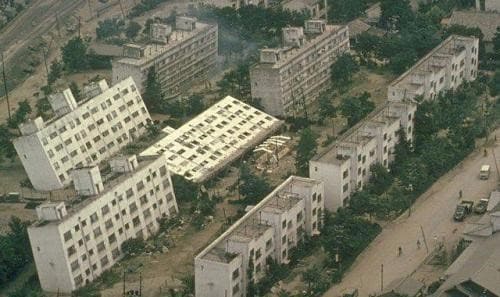The liquefaction phenomenon
Soil liquefaction generally occurs when water-saturated soil is subjected to seismic stress. Under the effect of a seismic wave, vibration or explosion, the soil loses some or all of its bearing capacity. The ground then behaves like a liquid.
This phenomenon is generally sudden and temporary, with the soil returning to its solid consistency afterwards.
The soils most susceptible to liquefaction are water-saturated soils such as sands, silts, gravels, clays and mine tailings with a uniform grain size of less than 2 mm, low density and cohesion. The consequences of this phenomenon impact buildings, earthworks and underground structures such as gas and water networks….
Around 20% of the world’s land is considered to be at risk of liquefaction in the event of an earthquake. In the United States, around 75 million people live in areas at risk of liquefaction. In Japan, the risk of liquefaction is particularly high due to the nature of the soil and the frequency of earthquakes. In 2011, the magnitude 9.0 earthquake that hit Japan caused severe damage due to liquefaction, particularly in the town of Sendai. Chile is also affected by the presence of a large volume of mine tailings from its many copper mines, which are used to build dykes and dams in a country that is prone to numerous earthquakes. The economic costs of soil liquefaction can run into billions of dollars, depending on the severity of the event and the population density in the affected area.
How can these phenomena be prevented?
The prevention of liquefaction phenomena requires a combination of geotechnical measures and appropriate planning when building structures in areas susceptible to soil liquefaction.

The first is to measure the risks through an in-depth geotechnical study to assess the composition of the soil and all the factors that can contribute to liquefaction.
Over the last 20 years or so, a number of studies have been carried out in Clermont-Ferrand to propose methods for assessing liquefaction potential. They are based on data from the French variable-energy dynamic penetrometer Panda® (Pénétromètre Autonome Numérique Dynamique Assisté par ordinateur) and have been developed both in the laboratory and in the field. The French variable-energy dynamic penetrometer technique is of major interest for in situ liquefaction potential studies. The power of penetration, the simplicity, cost and time of the test, the ease of deployment in most configurations where the operator has access, but also and above all the finesse of the depth measurement make them highly suitable tools for identifying liquefiable layers. The associated instrumentation and post-processing software, including Websprint©, now includes a module for assessing the risk of liquefaction.
But beyond the geotechnical study, other complementary measures can be envisaged, such as draining the soil and consolidating it by adding granular materials or chemical binders to improve its properties, or simply compacting it to improve its density.
Finally, structures built in areas prone to liquefaction must be designed to withstand the forces and settling induced by this phenomenon. Special design techniques, such as deep piles, reinforced foundations or retaining walls, may be required to ensure the stability of structures.
It is important to note that total prevention of liquefaction can be difficult, especially in high-risk areas. However, by taking appropriate preventive measures, it is possible to significantly reduce the risks and improve the safety of structures. It is recommended that geotechnical and civil engineering experts be called in to assess the specific risks and implement the appropriate measures.
